
- Index
- Author
- Conflict
- Features
- 12-hour Dial (10)
- 24-hour Dial (9)
- Adjustable (29)
- Adjustable Strap (15)
- Ankle Strap (12)
- Arch Support (20)
- Chronograph (11)
- Collared (10)
- Date Indicator (11)
- Full Zip (28)
- Historic Culture (13)
- Hooded (7)
- Illustrated (30)
- Lightweight (10)
- Lined (11)
- Pockets (10)
- Retro (11)
- Reversible (6)
- Screw Down Crown (17)
- Water Resistant (10)
- Other (4357)
- Format
- Genre
- Theme
WWII Corporal wool jacket dress pilot uniform US Army 9th Air force Corp USAF

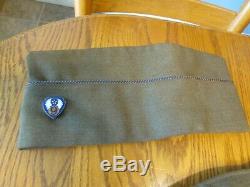
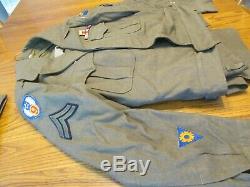

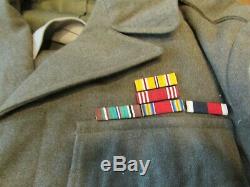
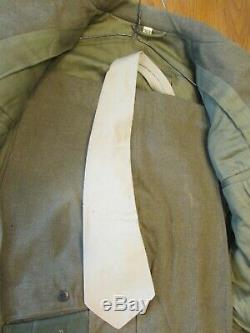

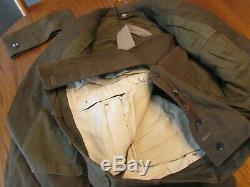
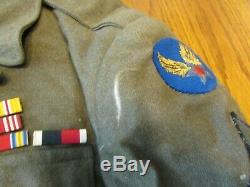

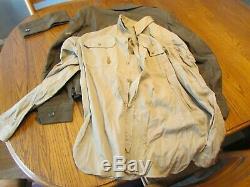



Tactical Thunder: The Ninth Air Force. The deployment of the Ninth Air Force brought the concept of tactical air support into action for the Allies. As the landing craft carrying the invading Allied ground forces of Operation Overlord motored toward the Normandy beaches on June 6, 1944, they were protected and supported by the largest aerial armada the world has ever seen. In spite of medium-level clouds, a covering umbrella of American and British fighters kept the skies clear of German fighters.
Squadrons of Douglas A-20 Havoc light bombers and fighter bombers came in low over the beaches to bomb and strafe German positions and gun emplacements on the shore. Large formations of Martin B-26 Marauder medium bombers dumped their bomb loads on German gun positions a few minutes before H-Hour. A stream of glider-towing transports passed over the ships that had brought the troops across the English Channel. Earlier that morning those same transports delivered loads of American and British paratroopers onto the drop zones around the town of St.
The American light and medium bombers, fighter bombers, and transports were all from Lt. Breretons United States Ninth Air Force. Along with the British Second Tactical Air Force, the Ninth Air Force was formed specifically to support the ground forces whose lot was to fight in Western Europe.
The D-Day landings commenced the final and best-known period of Ninth Air Forces wartime service, but by June 6, 1944, it had been in combat almost two years and was in the second phase of the its colorful history. Furthermore, the Ninth Air Force of Normandy and Western Europe took an entirely different role than it played in 1942 and 1943, when it was a multifunction U. Army air force assigned to support British forces and conduct strategic bombing operations in the Middle East. The creation of the unit that came to be known as the Ninth Air Force occurred in a somewhat roundabout manner, primarily as a result of Allied reactions to enemy activity in different parts of the globe.In early 1942, the Allied Combined Chiefs of Staff decided to consider the Far East and Middle East as interdependent areas of operation, with resources to be allocated according to the military situation at the time. The air routes that had been established from the United States and Europe to the Far East passed through the Middle East, so it was logical to consider the two areas together when it came to reinforcement in time of emergency. A pair of Curtiss P-40 Warhawk fighters takes off from an airfield in Egypt to strafe Axis troop and supply columns in the North African desert.
These aircraft are part of the U. Middle East Air Force, and the photo was taken in July 1942. Aircraft and combat units from either area of operation could be rushed to the other, considering that they were on opposite sides of the vast Asian continent. Consequently, when the Japanese gained the advantage in Burma and China in the wake of the Doolittle Raid on Tokyo, thus ruling out planned heavy bomber operations against Japan, the U.
War Department decided to halt some of the combat units that had been destined for China in the Middle East to meet an emerging threat. The British Eighth Army was battling the Afrika Korps. The decision was prompted at least in part by German Field Marshal Erwin Rommels new offensive in Libya and western Egypt and the resulting threat to Cairo and Palestine. The first American air unit to serve in the Middle East was a special project under the command of Colonel Harry Halverson known as the Halverson Project, HALPRO for short. HALPRO was made up of a squadron of Consolidated B-24D Liberator bombers whose original mission had been to serve as the nucleus of a heavy bomber force based in China to begin a strategic bombing campaign against the Japanese mainland.Another force under the command of Colonel Caleb Haynes, known as AQUILA, had already arrived in India with a handful of Boeing B-17 Flying Fortress bombers and Douglas C-47 Skytrain transports with the same purpose in mind. These two forces were to combine and launch attacks on Japan. Before the heavy bombers arrived, President Franklin Roosevelt authorized a daring attack on Japan by Army B-25 Mitchell medium bombers launched from the aircraft carrier USS Hornet.
Although news of the raid was seen as a means of raising American morale, it was a disaster for the Chinese as Japanese troops invaded all areas from which future air attacks against Japan could be launched, killing more than 250,000 Chinese civilians in the process. Japanese troops took control of the regions where the bomber bases were under construction, leaving the B-17s and B-24s without an Asian mission. The HALPRO force was halted in the Middle East and the AQUILA B-17s were ultimately ordered to Palestine as well. The commander of the new Middle Eastern Air Force was Maj. Brereton, who came to the assignment in a manner even more roundabout than the creation of his new command. Brereton, who was one of the highest ranking officers in the Air Corps before the war, was in the Philippines on December 8, 1941, where he had just assumed command of the Far East Air Forces. Two weeks later, President Franklin Roosevelt and British Prime Minister Winston Churchill agreed to abandon the Philippines to their fate, and Brereton and his headquarters were ordered to Australia to organize an Allied air effort against the Japanese. Brereton was only in Australia for a little over two months; in March 1942 he transferred to India to organize and take command of the Tenth Air Force, a new organization planned for operations in the China-Burma-India Theater. Breretons stay in India was also short lived.In June he was ordered to Cairo to take command of American air operations in the Middle East. He was also ordered to take any available bombers and all of the transports in India with him.
The B-17s of the 9th Bombardment Squadron, the former AQUILA project, were part of the move. In 1941, after an inspection trip of British air forces in the region, Maj. George Brett recommended the long-range B-24 Liberator as the ideal heavy bomber for the Middle East, and deliveries of the four-engine bombers to the Royal Air Force soon commenced. By mid-1942, when the first American air units arrived, one squadron of Royal Air Force Liberators was operational in Palestine.When America entered the war, the British immediately requested the assignment of American heavy bombers to the Middle East, but the air staff balked, reasoning that any bombers sent there would take away from the planned buildup of a heavy bomber force in Britain. The changing military situation in Libya and Egypt led to a change of heart; the War Department decided to establish an air force in the Middle East with one heavy bomber group, two of medium bombers, and six pursuit groups.
Breretons new command was initially organized as the Middle Eastern Air Force, but plans were laid for it to become the Ninth Air Force once all of the necessary units had reached the theater. As the situation in China deteriorated, ruining American plans for an air offensive against Japan from Chinese bases, Army Air Forces commander General Henry Hap Arnold obtained permission from President Roosevelt to halt the secret HALPRO force in the Middle East. Arnold planned to use the B-24s for a strike on the oil refinery complex at Ploesti, Romania, which was the largest single source of all German gasoline and oil supplies and one of the most important targets in the ETO. The mission against Ploesti was flown on the night of June 12, 1942, with negligible results, but it did have the distinction of being the first American bombing mission of the war with strategic objectives.
Ninth Air Force would be going back to Ploesti. After the first Ploesti mission, HALPRO remained at Lydda, Palestine, as the HAL Squadron for operations in support of the British Eighth Army against Rommels Afrika Korps. Its B-24s and the 9th Bombardment Squadrons B-17s formed the nucleus of what would become the IX Bomber Command. On July 20, the two squadrons were organized into the 1st Provisional Group (Bombardment).
The combined strength of the HAL and 9th Squadrons amounted to only 28 heavy bombers19 B-24s and nine B-17s. Although the number of Liberators would increase, B-17 strength remained at less than a dozen airplanes. This Consolidated B-24 Liberator bomber nicknamed Jerks Natural participated in the epic August 1, 1943, American air raid on the oil refineries at Ploesti, Romania.Although the American and British Liberators struck targets as far west as Benghazi, Libya, the B-17s limited range restricted them to missions no farther than Tobruk. Reinforcements for the Middle Eastern Air Force came in late July, when the 344th Bombardment Squadron arrived as the advance element of the 98th Bombardment Group, which was on its way to Palestine from Florida.
Meanwhile, a group of medium bombers, B-25s of the 12th Bombardment Group, crossed the South Atlantic, then flew up through Central Africa to its new base in Egypt. Both the 12th Bombardment Group and the 57th Fighter Group went into training with the British before entering combat in North Africa.
The original comprehensive War Department plans for air strength in the Middle East were never reached, although heavy bomber strength would increase to twice that originally planned. Political maneuvering cost the Middle Eastern Air Forces some of its projected assets when newly promoted Brig.Doolittle, who enjoyed star status in Washington because of his Tokyo Raid, put pressure on Arnold to let him have the 33rd Fighter Group for his new Twelfth Air Force. The Twelfth Air Force was being formed to support the American landings at Casablanca, and it was siphoning off assets from other organizations. There was mixed reaction in Washington to the request as most of the air staff believed air superiority over the Western Desert would be beneficial to the overall success of the Allied campaign in North Africa. The War Department chose to leave the decision up to General Dwight D. Eisenhower, who was to command the invasion force.
Ike naturally wanted the group under his personal command, so the 33rd went to Twelfth. As a replacement for the 33rd and in recognition of the need for P-40s in Egypt, the War Department elected to send the 79th Fighter Group to the Middle East. Although the group arrived in October and many of its pilots flew combat missions with other organizations, the 79th did not become operational as a combat unit until the spring of 1943. Without their own fighter escortsthe 57th Group P-40s were working with the British Western Desert Air Forcethe Middle Eastern Air Force heavy bombers were forced to depend on the RAF for escort, or to go it alone to their targets. Unlike Generals Ira Eaker and Carl Spaatz, who had gone to England to organize a daylight bombing campaign, Brereton was not hamstrung with the desire to prove American theories on daylight bombing, so his bombers operated at night as well as by day.
Losses among heavy bombers operating in the Middle East were fairly light, especially in comparison to those starting to occur among the Eighth Air Force bombers on daylight missions over Western Europe. The heavy bombers were achieving considerable success as they struck targets all along the North African coast. Several ships were hit and some were sunk, and sticks of bombs fell on warehouses adjacent to the docks at Mediterranean ports. The brunt of the task was borne by the Liberators, since the Fortresses lacked the range to reach Benghazi from their bases in Palestine. The shorter range B-17s joined British Vickers Wellington bombers and American B-25s in strikes on Tobruk.
This Curtiss P-40 shown in flight is similar to those that were deployed with the U. Middle East Air Force during the fighting in North Africa. Pilots learned the skills needed for effective tactical air support while flying missions in support of General Bernard Montgomerys Eighth Army and the Allied forces that landed along the coast of West Africa during Operation Torch. Before American ground forces landed at Casablanca in early November, the British Eighth Army met and defeated the Afrika Korps at El Alamein in the decisive battle of the North African campaign. Prior to the battle, the RAF had more than 1,000 aircraft of all types in North Africa. Army Air Forces strength stood at 56 P-40s, 46 B-25s, and 63 heavy bombers, of which 10 were the war-weary B-17s Brereton had brought with him from India.Allied air strength outnumbered that of the Axis considerably. The Luftwaffe was tied down on the Eastern Front, where things had not gone well for the Germans since the previous winter. El Alamein was the first significant engagement for the U. Fighters, and the P-40 pilots of the 57th Fighter Group made a good showing.
They joined with RAF P-40s in fighter bomber attacks on German positions and engaged German and Italian planes in the air. Changes in IX Bomber Command. Throughout the summer of 1942, the formal organization of the Middle Eastern Air Forces was limited. In October the IX Bomber Command was staffed, although the command itself remained in an unofficial status. Colonel Patrick Timberlake of Breretons staff took issue with British claims to control of the American heavy bombers, asserting that it was a violation of an agreement worked out between General Arnold and key British leaders that called for homogeneous American formations.
While Timberlake conceded that it might be appropriate for the U. Fighter and medium bomber groups, of which there was one of each in the Middle East at the time, to operate under British control, American heavy bombers constituted four-fifths of the heavy bomber strength in the theater. As a result of Timberlakes memo, the British agreed to the establishment of an American bomber command in Cairo, then went so far as to turn over their own Liberator squadron to its control. Timberlake was placed in command of the new IX Bomber Command.
On November 8, 1942, Lt. Frank Andrews took command of the U.
Army Air Forces Middle East. Army officer in the area, Andrews was an Air Corps officer who had his own ideas on organization of air forces, ideas that were becoming widely accepted in the overseas commands.
Four days after assuming command of the theater, Andrews issued a general order establishing the Ninth United States Army Air Force with Brereton in command. On the same day, Brereton activated IX Headquarters Squadron and IX Service Command.
Although it was already functioning in an unofficial status, IX Bomber Command was formally established two weeks later, on November 27. Smoke billows from the Aershot rail center 30 miles north of the Belgian capital of Brussels as three Douglas A-20 Hovoc light bombers from the Ninth Air Force speed away from the scene of destruction. The raid was conducted on May 7, 1944, a month before the D-Day landings in Normandy. With American troops ashore at Casablanca, the British Eighth Army began advancing westward into Libya.
The IX Bomber Command moved its bases to the Nile Delta from Palestine and established forward bases just west of Tobruk. On November 1, the 1st Provisional Group was reformed to become the 376th Bombardment Group, giving IX Bomber Command two full groups of B-24s. The remnants of the HALPRO force were reinforced and replaced by new personnel with new airplanes coming in from the United States.
A single squadron of B-17s remained in the command, but their slower speed and limited range prevented them from operating effectively with the Liberators. After the Casablanca landings, two B-17 groups left the Eighth Air Force in England and moved to North Africa to join Doolittles Twelfth Air Force.
In December the 93rd Bombardment Group, one of two B-24 groups in the Eighth Air Force, was deployed under temporary duty orders to North Africa with three of its four squadrons to supplement XII Bomber Command. The 93rd flew a couple of missions out of Algiers, then moved to western Egypt to join IX Bomber Command, where its B-24Ds would be operating with identical types.With the arrival of the 93rd, IX Bomber Command had control of three heavy bomber groups, a formidable force, and was able to begin mounting formations of considerable size. In return for the 93rd, the 9th Bombardment Squadron and its B-17s departed Egypt for North Africa and Twelfth Air Force, leaving the IX Bomber Command as an all B-24 force since the B-25s of the 12th Bombardment Group were still operating under British control. Throughout December and most of January, IX Bomber Command concentrated its efforts on German targets in Tunisia. On January 2, the 12th Bombardment Groups B-25s, which had previously operated under British control, joined the B-24s in an attack on Crete. It was the first mission for the medium bombers as part of IX Bomber Command.
An untimely dust storm wreaked havoc with the Mitchellsonly 12 of a planned 36 were able to take off and one of those turned back without reaching the target. Eleven Mitchells bombed their target, but two were lost on the return flight. Most of the others failed to make it back to their home base because of excessive fuel consumption and had to put down on other fields. By January two additional fighter groups had arrived in the theater, the promised 79th and the 324th.
Like the 57th that preceded them, the new groups were equipped with P-40s. Ninth Air Force also had received its own troop carrier group, the 316th, which was originally intended to go to a project in the Caucasus. The fighters continued to operate with the British, while the troop carrier transports went to work hauling supplies for the fighter and bomber squadrons and supporting the British ground forces. Air evacuation of casualties was a major mission of the troop carriers.
After the capture of Tripoli, IX Bomber Command turned its attention toward targets in Europe, specifically Naples, Messina, and Palermo. The three cities were important links in the Axis supply chain to Tunisia.The B-24s were still based in the Nile Delta but staged out of a forward base at Gambut near Tobruk, where the bombers were refueled before departing for the long missions to Sicily and Italy. In late January the B-24 groups left the Nile Delta and moved the 300 miles to Gambut-Main. With the Allied victory in Tunisia, the Ninth Air Force turned toward the reduction of enemy defenses and transportation centers in preparation for the upcoming invasion of Sicily. Liberators of the IX Bomber Command joined with Twelfth Air Force B-17s in attacks on targets in Italy and airfields and other complexes in Sicily.
Some of the 12th Bombardment Groups B-25s were attached to Twelfth Air Force to support the invasion. In preparation for the landings, IX Bomber Command was reinforced with three Eighth Air Force B-24 groups: the veteran 93rd, which had served with IX Bomber Command in the winter, along with the 44th and 389th Groups. At the time, the three groups constituted all of VIII Bomber Commands Liberator strength. The new groups joined the 98th and 376th at bases in the vicinity of Benghazi, Libya, and participated in raids on targets in support of the upcoming invasion of Sicily.On July 19, IX Bomber Commands B-24s, supplemented by the Eighth Air Force groups, joined Twelfth Air Force B-17s in an attack on railroad marshaling yards around Rome. Ground crewmen bomb up and droop snoot a Lockheed P-38 Lightning fighter bomber in preparation for a raid on enemy installations in occupied France. This version of the famed Lightning is called a droop snoot because of its glass-enclosed nose and the addition of a bombardier during missions.
The arrival of the additional B-24s from England had a dual purpose. Not only were they there to increase heavy bomber strength in the Mediterranean for the Sicily campaign, their presence was prompted to a large degree by the most ambitious plan of the wara low-level attack on the Ploesti oil fields, the same target that led to the assignment of the HALPRO force to the Middle East. On August 1, 1943, five B-24 groups departed Benghazi and set out across the Mediterranean for Ploesti. The B-24s came in over the refineries at treetop level in the face of intense enemy fire. In spite of heavy casualties, most crews managed to put their bombs into the refinery complex, although some of the groups struck targets other than the ones they had been assigned.A navigational error on the part of the lead formation caused some of the B-24s to fail to bomb their intended targets, and most of one group failed to bomb the refineries at all, causing the mission to be less of a success than planned. Less than two weeks later, the combined force of Liberators struck the aircraft factories at Wiener Neustadt, Austria. Once Allied troops were ashore in Sicily and Italy, the Army Air Forces began a massive reorganization in preparation for the invasion of Normandy. At the Casablanca Conference in early 1943, the Allied leaders agreed to conduct a combined bomber offensive against Germany from British and Italian bases. The Eighth Air Force in England would be the northern arm of the American strategic bomber force, and plans were made for the creation of a second force that would attack targets in Germany from the south.
A new headquarters derived from Headquarters, Eighth Air Force, the U. Strategic Air Forces, was planned to control heavy bomber operations against Germany. The success of RAF, Ninth, and Twelfth Air Force fighter bombers and light and medium bombers in support of ground forces led to the decision to also establish tactical air forces dedicated to ground support. The result was the decision to transfer Ninth Air Force to England, where it would become the American tactical air force responsible for supporting the Normandy landings and subsequent ground operations in Western Europe.
The RAF established a counterpart as II Tactical Air Force. In preparation for the move, the Ninths fighter and medium bomber groups transferred to Twelfth Air Force, which had been given the same mission in the Mediterranean, and IX Bomber Commands two B-24 groups joined the B-17s from the Twelfth Air Force to form the newly established Fifteenth Air Force. The idea for a separate tactical air force in England had been developed as early as May 1943, with initial plans for it to emanate from the VIII Support Command. The unit started appearing in planning papers as the Eighth Tactical Air Force, but plans were soon made to form an air force-level unit entirely separate from and equal to the Eighth Air Force. On July 31, General Arnold offered command of the new unit to General Brereton since plans were already under way for Ninth Air Force assets in the Middle East and North Africa to be rolled into the Twelfth Air Force and for the heavy bombers to go to the new Fifteenth. Having served in three theaters and several major campaigns, Brereton was the most widely experienced general officer in the U. He arrived in England on September 10, where he conferred with Lt.Ira Eaker, who at the time was the senior U. Officer in England, then departed for the United States for a meeting with Arnold and a short leave. Brereton was back in England by mid-October.
During the various discussions, the Army Air Forces staff had decided that only the Ninth Air Force headquarters and the headquarters of the IX Bomber, Fighter and Service commands would go to England. Eighth Air Force would provide Ninth with its initial combat and service units, but the bulk of the new tactical air force would come with units arriving from the United States.
Ninth Air Force in England. On October 15, four medium bomber and two troop carrier groups transferred from the Eighth to the Ninth Air Force to became its first operational units in England.
The 322nd, 323rd, 386th, and 387th Bombardment Groups were equipped with Martin B-26 medium bombers, while the troop carrier groups flew Douglas C-47s. The first fighter group to join the new Ninth Air Force was the 354th, a unit whose arrival in England was a milestone in the air war since it was equipped with North American P-51B Mustangs at a time when U. Fighter squadrons in Europe were equipped with Lockheed P-38 Lightnings and Republic P-47 Thunderbolts. Several VIII Fighter Command pilots, including Lt. Don Blakeslee, were temporarily assigned to the 354th to train the newly arrived pilots for combat.
They were so impressed with the P-51 that they mounted a campaign to have all future P-51 groups assigned to VIII Fighter Command. Their campaign was successful, and by mid-1944 most of the Eighths fighter groups were equipping with Mustangs, and the P-47s they had been flying were going to groups assigned to Ninth.Although initial plans called for several P-51 groups with the Ninth, only two Mustang-equipped fighter groups and a reconnaissance group were actually assigned to the Ninth Air Force. All of the other fighter groups flew P-47s, except for three groups that were equipped with P-38s. A Luftwaffe pilot hits the silk as his burning plane tumbles out of control. This still image from the gun camera footage filmed by the fighter bomber of Major James Dalglish vividly illustrates the capability of Ninth Air Force planes to perform multiple combat roles. Dalglish scored this aerial victory over Belgium during the Battle of the Bulge in late 1944.
The diversion of the P-51s to VIII Fighter Command came about because of military politics, which seemed to be prevalent in the European Theater. Strategic Air Forces, Europe, the new command that had been created to oversee U. Army heavy bomber operations against Germany. As the senior Army Air Forces officer in Europe, Spaatz lost no time exerting the power of his new rank and position.
He sought to exercise control over all U. Air units in England, especially Ninth Air Force. During the planning for the new tactical air force, Brereton and Army Air Forces planners had visualized it as an independent command apart from the strategic bomber forces since its mission was the dedicated support of the ground war. When he got wind of the plan, Spaatz became incensed. As the senior air officer in Europe, he did not wish to have another Army Air Forces command operating on what he considered to be his private turf.
In a preemptive move, he wrote a strong letter to Brereton making it clear that he was going to control the Ninth Air Force and, furthermore, that he would be the link in the chain of command between the Ninth Air Force and Headquarters, U. Army Air Forces in Washington. Brereton and his staff were already inclined to believe that Spaatz was discriminating against them in favor of the Eighth Air Force. Spaatz outranked Brereton, both in military rank and command authority, so the Ninth Air Force commander was in no position to dispute the senior commanders authority. Several senior officers in Washington felt that it was a mistake for a strategic bombing organization to have control of an air force that was charged with supporting ground forces, but in the end Arnold went along with Spaatz.This arrangement was problematic, but as the D-Day landings approached Supreme Allied Commander Dwight Eisenhower temporarily solved the problem by placing all of the air units under his direct command. Eisenhower issued an order that all air operationsincluding heavy bomberswould be in support of the ground forces until the Normandy beachhead had been established.
The item "WWII Corporal wool jacket dress pilot uniform US Army 9th Air force Corp USAF" is in sale since Saturday, July 6, 2019. This item is in the category "Collectibles\Militaria\WW II (1939-45)\Original Period Items\United States\Uniforms".The seller is "208picker" and is located in Boise, Idaho. This item can be shipped to United States.

